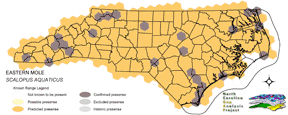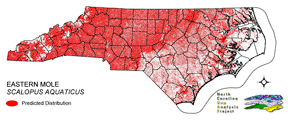
| Taxa: |
| Order: |
| Family: |
| Mammalia |
| Insectivora |
| Talpidae |
| NatureServe Global Rank: |
| NatureServe State (NC) Rank: |
| G5 |
| S5 |
| Federal Status: |
| NC State Status: |
| --- |
| --- |


| Land Unit |
| US Fish & Wildlife Service |
| US Forest Service |
| US National Park Service |
| US Department of Defense |
| NC State Parks |
| NC University System |
| NC Wildlife Res. Com. |
| NC Forest Service |
| NC Div. of Coastal Mgmt. |
| Local Governments |
| Non-Governmental Org. |
| Other Public Lands |
| Private Lands |
| GAP Status 1-2 |
| All Protected Lands |
| Statewide |
| Hectares |
| 13,853.79 |
| 243,735.03 |
| 45,328.14 |
| 47,855.43 |
| 27,913.14 |
| 12,651.39 |
| 43,330.50 |
| 7,725.06 |
| 886.23 |
| 5,445.63 |
| 6,860.43 |
| 3,062.52 |
| 6,075,824.04 |
| 140,240.16 |
| 455,903.01 |
| 6,534,471.33 |
| Acres |
| 34,233.45 |
| 602,282.26 |
| 112,008.25 |
| 118,253.32 |
| 68,974.86 |
| 31,262.26 |
| 107,071.98 |
| 21,858.30 |
| 2,189.92 |
| 13,456.44 |
| 16,952.49 |
| 7,567.65 |
| 15,013,685.25 |
| 349,310.17 |
| 1,129,329.91 |
| 16,149,796.42 |
| % of Dist. on |
| Prot. Lands |
| 3.0 % |
| 53.5 % |
| 9.8 % |
| 10.5 % |
| 6.1 % |
| 2.8 % |
| 9.4 % |
| 1.7 % |
| 0.2 % |
| 1.4 % |
| 1.4 % |
| 0.5 % |
| < 0.1 % |
| 30.8 % |
| ----- |
| ----- |
| % of Dist. on |
| All Lands |
| 0.2 % |
| 3.7 % |
| 0.7 % |
| 0.7 % |
| 0.4 % |
| 0.2 % |
| 0.7 % |
| 0.1 % |
| < 0.1 % |
| < 0.1 % |
| 0.1 % |
| < 0.1 % |
| 93.0 % |
| 2.1 % |
| ----- |
| ----- |
|
Having the broadest range in eastern North America, S. aquaticus is abundant in the Piedmont and Coastal Plain of North Carolina, where it even occurs on the larger islands of the Outer Banks, but very localized and rare in the mountains, where it is restricted to river bottoms and low-lying habitats (Webster et al. 1985). Loose sandy to loamy soils are a key habitat feature (Whitaker and Hamilton 1998). The mole seems to avoid soils and substrates of heavy clay, gravelly or stony content, or dry or wet moisture extremes. Land cover appears to be less of a habitat criteria for S. aquaticus as they occur in cover types from forests to grasslands (Brown 1997). However, grassy fields, meadows, pastures, and open forest typically contain the highest population densities (Webster et al. 1985). This mole is commonly found burrowing under lawns and in gardens of residential and urban areas. NATURE SERVE GLOBAL HABITAT COMMENTS: Most commonly occurs in open areas with moist soils, such as lawns, meadows, and golf courses. Bottomland wooded areas also are utilized. Soft humid soils are preferred over gravelly, dry soils. Two types of underground passageways: near-surface and deep. Surface are commonly seen with their raised ridges. Deep (10-24') provide wintering/breeding areas. Den sites often are located under protection of a surface object. |
| Code | Name | Description | NC Natural Heritage Program Equivalent |
| 121 | Maritime Pinelands | Loblolly forests and woodlands of the outer coastal plain. | Estuarine Fringe Loblolly Pine Forest |
| 17 | Maritime Forests and Hammocks | Maritime forests and woodlands dominated by live or sand laurel oak. Estuarine Fringe forests dominated by loblolly pine. | Coastal Fringe Evergreen Forest, Maritime Deciduous Forest, Maritime Deciduous Forest |
| 63 | Coastal Plain Mesic Hardwood Forests | Beech dominated forests with white oak and northern red oak as possible co-dominants. Dry-mesic to mesic forests on slopes and small stream bottoms in the coastal plain. | Mesic Mixed Hardwood Forest, Basic Mesic Forests |
| 138 | Coastal Plain Dry to Dry-Mesic Oak Forests | Oak dominated forests of the coastal plain. Includes white oak forests with water oak or northern red oak and hickories as co-dominants. | Dry Mesic Oak Hickory Forest, Basic Oak Hickory Forest, Dry Oak Hickory Forest |
| 97 | Mesic Longleaf Pine | Longleaf pine woodlands without a major scrub oak component. Slash or loblolly pines may be present as well. | Mesic Pine Flatwoods |
| 230 | Piedmont Mesic Forest | American Beech - Red Oak - White Oak Forests. | Mesic Mixed Hardwood |
| 383 | Piedmont Mixed Successional Forest | Generally loblolly mixed with successional hardwoods. Sweetgum, tulip poplar and red maple are common co-dominants in these successional forests. | No equivalent |
| 228 | Piedmont Dry-Mesic Oak and Hardwood Forests | Primarily oak dominated forests, white oak is often dominant, with co-dominants including . Also represented by sweetgum and tulip poplar dominated forests. | Dry Mesic Oak Hickory Forest, Basic Oak Hickory Forest, Dry Oak Hickory Forest |
| 222 | Piedmont Dry-Mesic Pine Forests | Loblolly dominated forests resulting from succession following clearing. This type occurs on all moisture regimes following disturbance with the exception of the extremely xeric sites. | No equivalent |
| 382 | Dry Mesic Oak Pine Forests | Mixed forests of the coastal plain and piedmont. Includes loblolly pine with white, southern red and/or post oak and loblolly with water oak. On basic sites of the piedmont, eastern red cedar may co-occur with post, black, and blackjack oaks. | Dry Mesic Oak Hickory Forest, Xeric Hard Pan Forest, Chestnut Oak Forest, Dry Mesic Oak Hickory Forest, Dry Oak Hickory Forest |
| 21 | Coniferous Cultivated Plantation (natural / planted) | Managed pine plantations, densely planted. Most planted stands are loblolly, but slash and longleaf occur as well. | No equivalent |
| 51 | Deciduous Cultivated Plantation | Planted deciduous trees. Includes sweetgum and sycamore plantations. | No equivalent |
| 36 | Successional Deciduous Forests | Regenerating deciduous trees with a shrub stature. Commonly dominated by sweetgum, tulip poplars and maples. | No equivalent |
| 205 | Agricultural Pasture/Hay and Natural Herbaceous | Farm fields used for pasture grass or hay production, as well as old fields dominated by native and exotic grasses. | No equivalent |
| 202 | Residential Urban | Includes vegetation interspersed in residential areas. Includes lawns, mixed species woodlots, and horticultural shrubs. Vegetation accounts for between 20 - 70% of the cover. | No equivalent |
| 517 | Hemlock Floodplain Forest | Alluvial forest with hemlock and/or white pine in mountains and western piedmont. Hydrology is generally temporarily to seasonally flooded. | Canada Hemlock Forest |
|
Harvey, M.J. 1976. Home range, movements, and diel activity of the eastern mole, Scalopus aquaticus. Am. Midl.Nat. 95(2):436-445.
Jackson, H. H. T. 1915. A review of the American moles. North American Fauna 38:1-100. Jones, J. K., Jr., et al. 1992. Revised checklist of North American mammals north of Mexico, 1991. Occas. Pap. Mus., Texas Tech Univ. (146):1-23. Wilson, D. E., and D. M. Reeder (editors). 1993. Mammal Species of the World:a Taxonomic and Geographic Reference. Second Edition. Smithsonian Institution Press, Washington, DC. xviii + 1206 pp. Brown, L. N. 1997. A guide to the mammals of the southeastern United States. University of Tennessee Press, Knoxville. xiv + 236 pp. Whitaker, J.O. Jr. and W.J. Hamilton, Jr. 1998. Mammals of the eastern United States. Cornell Univ. Press, Ithaca, New York. 583 pp. Yates, T.L. and D.J. Schmidly. 1978. Scalopus aquaticus. Am. Soc. Mamm., Mammalian Species No. 105. 4pp. Godin, A.J. 1977. Wild Mammals of New England. Johns Hopkins University Press, Baltimore. 304 pp. Hamilton, William J., Jr., and John O. Whitaker, Jr. 1979. Mammals of the eastern United States. Cornell Univ. Press, Ithaca, New York. 346 pp. Hall, E. R. 1981. The Mammals of North America. Second edition. 2 Volumes. John Wiley and Sons, New York, New York. Schwartz, Charles W., and Elizabeth R. Schwartz. 1981. The wild mammals of Missouri. University of Missouri Press, Columbia. 356 pp. Baker, Rollin H. 1983. Michigan mammals. Michigan State University Press. 642 pp. van Zyll de Jong, C. G. 1983. Handbook of Canadian Mammals. 1. Marsupials and insectivores. Nat. Mus. Canada, Ottawa. 212 pp. Webster, W. D., J. F. Parnell and W. C. Biggs Jr. 1985. Mammals of the Carolinas, Virginia, and Maryland. The University of North Carolina Press, Chapel Hill, NC. Caire, W., J. D. Tyler, B. P. Glass, and M. A. Mares. Z. Marsh (illustrator). 1989. Mammals of Oklahoma. University of Oklahoma Press, Norman. Oklahoma. 567 pp. Gorman, M. L., and R. D. Stone. 1990. The natural history of moles. Cornell Univ. Press. 208 pp. |
For more information please contact them at:
NC-GAP Analysis Project
Dept. of Zoology, NCSU
Campus Box 7617
Raleigh, NC 27695-7617
(919) 513-2853
a target="_blank">www.basic.ncsu.edu/ncgap